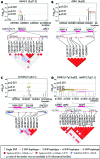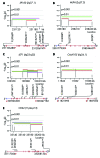High throughput SNP and expression analyses of candidate genes for non-syndromic oral clefts
- PMID: 16415175
- PMCID: PMC2564555
- DOI: 10.1136/jmg.2005.040162
High throughput SNP and expression analyses of candidate genes for non-syndromic oral clefts
Abstract
Background: Recent work suggests that multiple genes and several environmental risk factors influence risk for non-syndromic oral clefts, one of the most common birth defects in humans. Advances in high-throughput genotyping technology now make it possible to test multiple markers in many candidate genes simultaneously.
Methods: We present findings from family based association tests of single nucleotide polymorphism (SNP) markers in 64 candidate genes genotyped using the BeadArray approach in 58 case-parent trios from Maryland (USA) to illustrate how multiple markers in multiple genes can be analysed. To assess whether these genes were expressed in human craniofacial structures relevant to palate and lip development, we also analysed data from the Craniofacial and Oral Gene Expression Network (COGENE) consortium, and searched public databases for expression profiles of these genes.
Results: Thirteen candidate genes showed significant evidence of linkage in the presence of disequilibrium, and ten of these were found to be expressed in relevant embryonic tissues: SP100, MLPH, HDAC4, LEF1, C6orf105, CD44, ALX4, ZNF202, CRHR1, and MAPT. Three other genes showing statistical evidence (ADH1C, SCN3B, and IMP5) were not expressed in the embryonic tissues examined here.
Conclusions: This approach demonstrates how statistical evidence on large numbers of SNP markers typed in case-parent trios can be combined with expression data to identify candidate genes for complex disorders. Many of the genes reported here have not been previously studied as candidates for oral clefts and warrant further investigation.
Conflict of interest statement
Competing interests: none declared
References
-
- Lidral A C, Murray J C. Genetic approaches to identify disease genes for birth defects with cleft lip/palate as a model. Birth Defects Res A Clin Mol Teratol 200470893–901. - PubMed
-
- Beaty T H, Maestri N E, Hetmanski J B, Wyszynski D F, Vanderkolk C A, Simpson J C, McIntosh I, Smith E A, Zeiger J S, Raymond G V, Panny S R, Tifft C J, Lewanda A F, Cristion C A, Wulfsberg E A. Testing for interaction between maternal smoking and TGFA genotype among oral cleft cases born in Maryland 1992–1996. Cleft Palate Craniofac J 199734447–454. - PubMed
-
- Marazita M L, Murray J C, Lidral A C, Arcos‐Burgos M, Cooper M E, Goldstein T, Maher B S, Daack‐Hirsch S, Schultz R, Mansilla M A, Field L L, Liu Y E, Prescott N, Malcolm S, Winter R, Ray A, Moreno L, Valencia C, Neiswanger K, Wyszynski D F, Bailey‐Wilson J E, Albacha‐Hejazi H, Beaty T H, McIntosh I, Hetmanski J B, Tuncbilek G, Edwards M, Harkin L, Scott R, Roddick L G. Meta‐analysis of 13 genome scans reveals multiple cleft lip/palate genes with novel loci on 9q21 and 2q32–35. Am J Hum Genet 200475161–173. - PMC - PubMed
-
- Jezewski P A, Vieira A R, Nishimura C, Ludwig B, Johnson M, O'Brien S E, Daack‐Hirsch S, Schultz R E, Weber A, Nepomucena B, Romitti P A, Christensen K, Orioli I M, Castilla E E, Machida J, Natsume N, Murray J C. Complete sequencing shows a role for MSX1 in non‐syndromic cleft lip and palate. J Med Genet 200340399–407. - PMC - PubMed
-
- Zucchero T M, Cooper M E, Maher B S, Daack‐Hirsch S, Nepomuceno B, Ribeiro L, Caprau D, Christensen K, Suzuki Y, Machida J, Natsume N, Yoshiura K, Vieira A R, Orioli I M, Castilla E E, Moreno L, Arcos‐Burgos M, Lidral A C, Field L L, Liu Y E, Ray A, Goldstein T H, Schultz R E, Shi M, Johnson M K, Kondo S, Schutte B C, Marazita M L, Murray J C. Interferon regulatory factor 6 (IRF6) gene variants and the risk of isolated cleft lip or palate. N Engl J Med 2004351769–780. - PubMed
Publication types
MeSH terms
Substances
Grants and funding
LinkOut - more resources
Full Text Sources
Medical
Molecular Biology Databases
Miscellaneous


